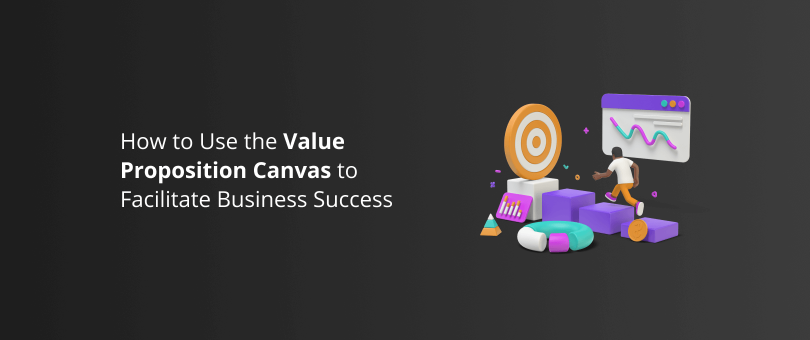Finding the best product-market fit is one of the cornerstones of business success. The value proposition canvas is a tool, designed to help companies do this with ease, by matching their solutions with the customer’s needs, and market demand.
The framework encourages businesses to research and understand their target audience in order to provide products that are just as the customer would imagine them to be, but better. Leveraging this information, companies can also map their client’s most important characteristics and work on adjusting their value proposition so that it delivers.
In this article, we explain the framework and show you how to fill your own value proposition canvas.
What Is the Value Proposition Canvas?
The value proposition canvas (VPC) is a business framework developed by innovation expert and entrepreneur Dr. Alexander Osterwalder.
It can be used both in new product development and in improving existing products and services. It represents a two-sided graph that showcases the product’s features and characteristics, a.k.a. the company’s value proposition, on one side, and the client’s needs and desires, a.k.a. the customer’s profile, on the other.
The goal of the value proposition canvas is for companies to understand what motivates purchase decisions and behavior. This knowledge enables them to make sure that their offer lives up to the client’s requirements.
The customer’s side of the framework is a circle, divided into three parts, and the company’s side is a square, also divided into three parts. The sections of the two sides are correlated and mirror each other:
Customer profile:
- Jobs-to-do
- Pains
- Gains
Value proposition:
- Product and services
- Pain relievers
- Gain creators
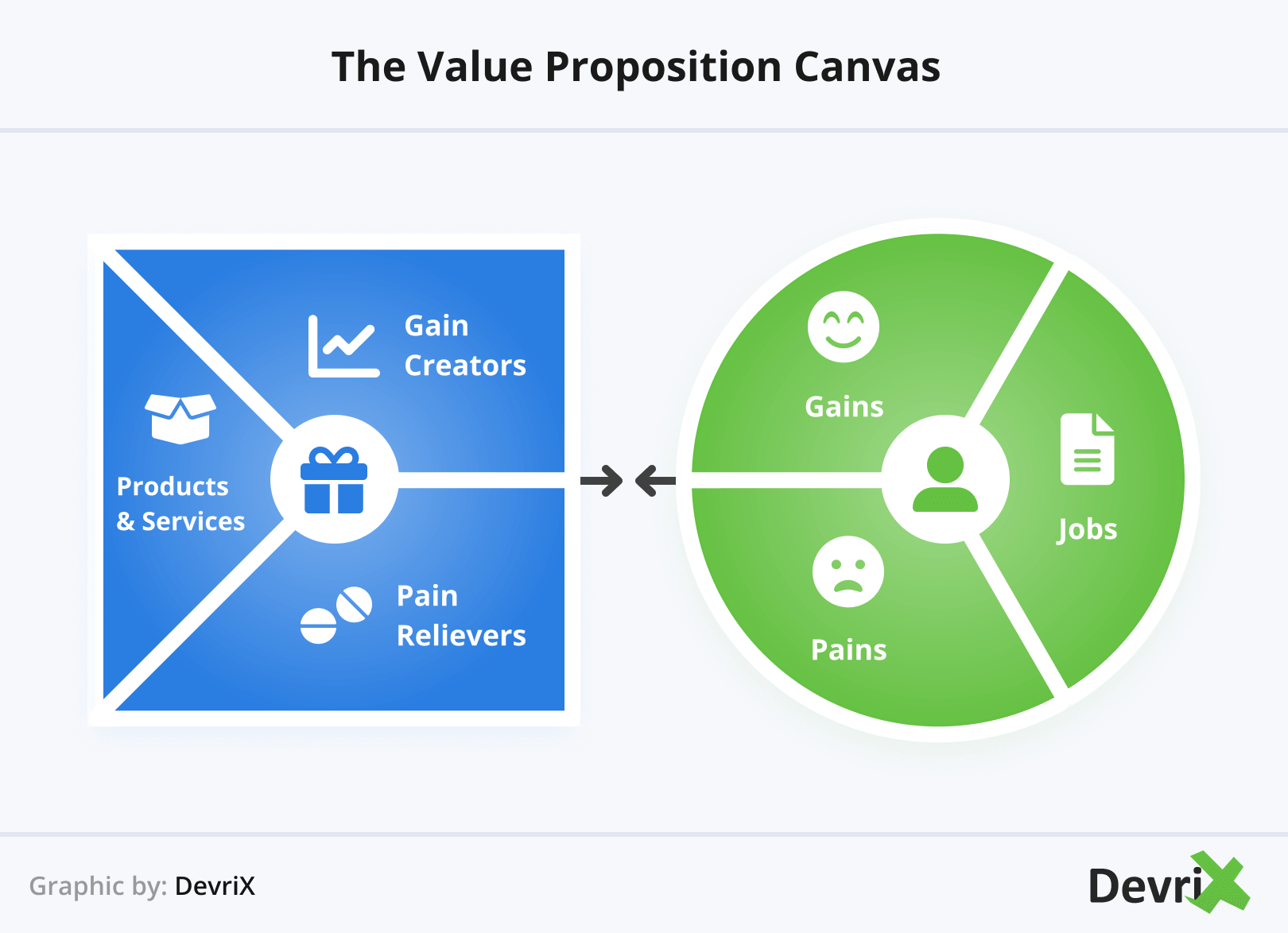
The Benefits of Using the Value Proposition Canvas
The value proposition canvas enables businesses to focus on the client rather than on their products. This way they can understand their target audience better, clearly spot any gaps in their product’s design, and identify potential development opportunities.
Filling out the value proposition canvas helps companies to build a bridge between their business and their customers, and identify the most efficient selling points.
Furthermore, it can also facilitate demand creation and demand generation. When you know what the customer wants and why, you can increase their perceived value of the product.
After all, what your clients are looking for are not just awesome features, but hands-on solutions to their problems. Of course, a feature is usually designed to resolve a certain issue. However, this means nothing to the customer, if they don’t understand how they can benefit from it.
By focusing on the customer’s POV, you can inform your marketing strategy better and create better targeted campaigns that are personalized to match every customer’s requirements. When your value proposition delves into pains, gains, and practical solutions, rather than the product’s qualities, people are more likely to relate.
In a nutshell, leveraging the framework, companies can create a powerful value proposition and improve their marketing message. As a result, they can boost sales, and increase loyalty and retention.
How to Fill the Value Proposition Canvas?
When filling the value proposition canvas, make sure to list 5 things in each section. Less will mean that you probably don’t have enough information, and more than 7 could result in you losing your focus.
Customers may have hundreds of needs, but you should prioritize the most urgent ones, and make sure your product responds to those and exceeds expectations. Only then can you consider other ways to provide additional value.
Now let’s have a look at the two sides of the framework. To better illustrate how to fill in the value proposition canvas, let’s take a look at an example: a web development company and a digital publisher client that is starting from scratch and needs a website.
Client Profile
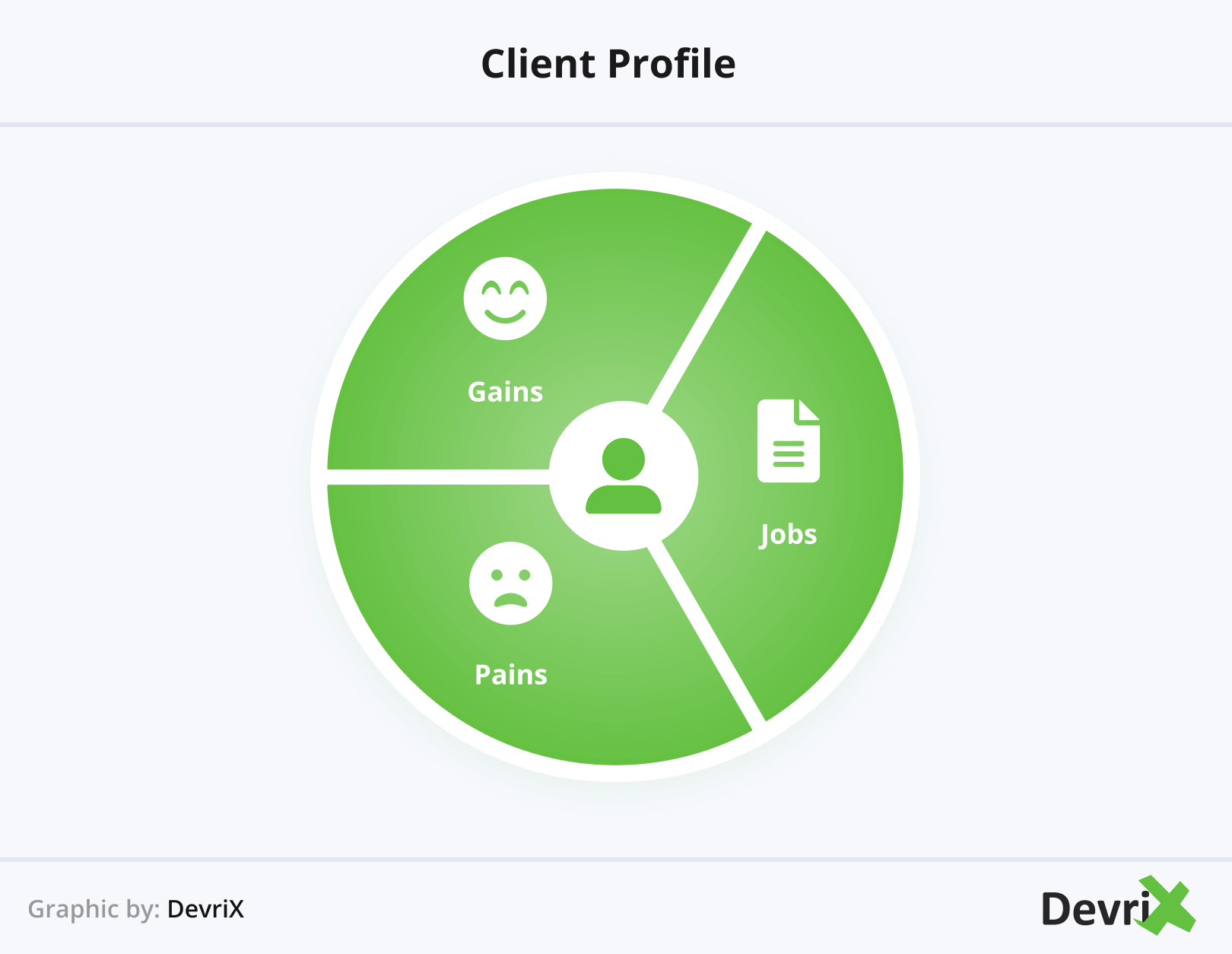
The customer profile should be based on validated data from sources such as a voice of customer study or other types of market research that your company has conducted. These will allow you to ask the right questions, test out solutions, adjust your strategy if needed, and, ultimately, design a product that the customer will fall in love with.
If you lack sufficient data and are not sure how the client feels, what drives their behavior and decisions, or what issues they face – simply ask them.
The client profile is based on your buyer persona profiles, so if you haven’t created them yet, you should start with that. Differentiate customer groups based on their needs, professional and personal profiles, their willingness to pay, and other relevant factors.
Once you have these in place, build a value proposition canvas for each one of them. The framework can help you reevaluate and further segment your personas – you may even find that there are divergences that you haven’t noticed before and that need to be targeted in different ways.
Jobs-to-Do
The customer’s jobs-to-do are the reasons why they may consider buying a product. This includes what they want to achieve, the problems they need to solve, future changes they long to make, and so forth.
There are, generally, three types of jobs-to-dos – social, functional and emotional. Not all of these apply to every client, but you should try to identify as many as possible.
In the example, what the customer wants is to have a website and build an online presence.
Dividing this into subgoals may look like the following:
- Social jobs. They want their website to look modern and professional so they have a competitive advantage over already established brands.
- Functional. They want the website to be intuitive and easy to use, by both administrators and followers. They expect to upload a lot of content daily, and build traffic.
- Emotional. They want to build a brand, and rely on the fact that the website will be up to the task. However, they might not be sure whether WordPress is a reliable platform, and can meet their expectations.
Pains
Pains are, generally, the constraints, setbacks, risks, and deal-breakers for the customer. These are the reasons why they may choose one provider over the other. Pains often include the price, deadlines, and quality of service. A pain can also be the customer’s lack of understanding of the issue at hand, and their need for professional assistance that may or may not be provided by the company.
To continue our example, the pains of the client might be:
- The price of the website development. They may be wary of the cost and whether they can afford a top-performing solution.
- Their lack of experience. They may not be sure that their editors and writers will be able to operate the content management system. They may fear that it will be too much of a hassle, and this will hurt the workflow and slow down the publishing process.
- Ad management. Living up to Google’s standards is a major issue even for experienced digital publishers and without an expert partner to handle it, the company may be penalized and lose traffic.
- Scalability and traffic. Their traffic might be scarce in the beginning. However, in the future, they will most likely want to scale their website and grow their presence. Also, they may worry that unexpected traffic surges (due to breaking news, for example) may cause the website to crash.
- Maintenance and availability. In-house IT might not be possible for a startup. Therefore, they will need a company that provides 24-hour customer service, so they can respond to crises and fix issues in a timely manner.
- Design. The website design needs to stand out and be recognizable, but, at the same time, not too intrusive so it doesn’t distract from the content.
Gains
Gains are not viewed as the opposite of pains. If resolving a pain is the bare minimum of what you can do to answer the customer’s needs, then gains are the benefits that exceed the client’s expectations. Providing gains can convince clients to choose one provider over the other.
Continuing with the example, some benefits might be:
- Business consulting. As they most likely lack experience themselves, the client needs an experienced partner who can advise them on what features, designs, and solutions would work best for them.
- Training and onboarding. The employees who will operate and manage the website will need training and onboarding to get them started.
- SEO optimization. A well optimized website will make it easier for the publisher to quickly build an online presence. As they are new to the business, they may not know what they need, so they are looking for an experienced company that is familiar with the latest digital publishing trends, and search engine algorithm updates.
- A particular deadline. They may have a plan when to launch their brand, and may be looking for a company that can deliver results in their desired time-frame.
- All-inclusive services. They may need marketing advice on how to reach their KPIs, what SEO goals and techniques to employ, and how to optimize their content. If a web development company offers this service, they may choose it over others to save themselves the hassle of working with different agencies.
Value Proposition
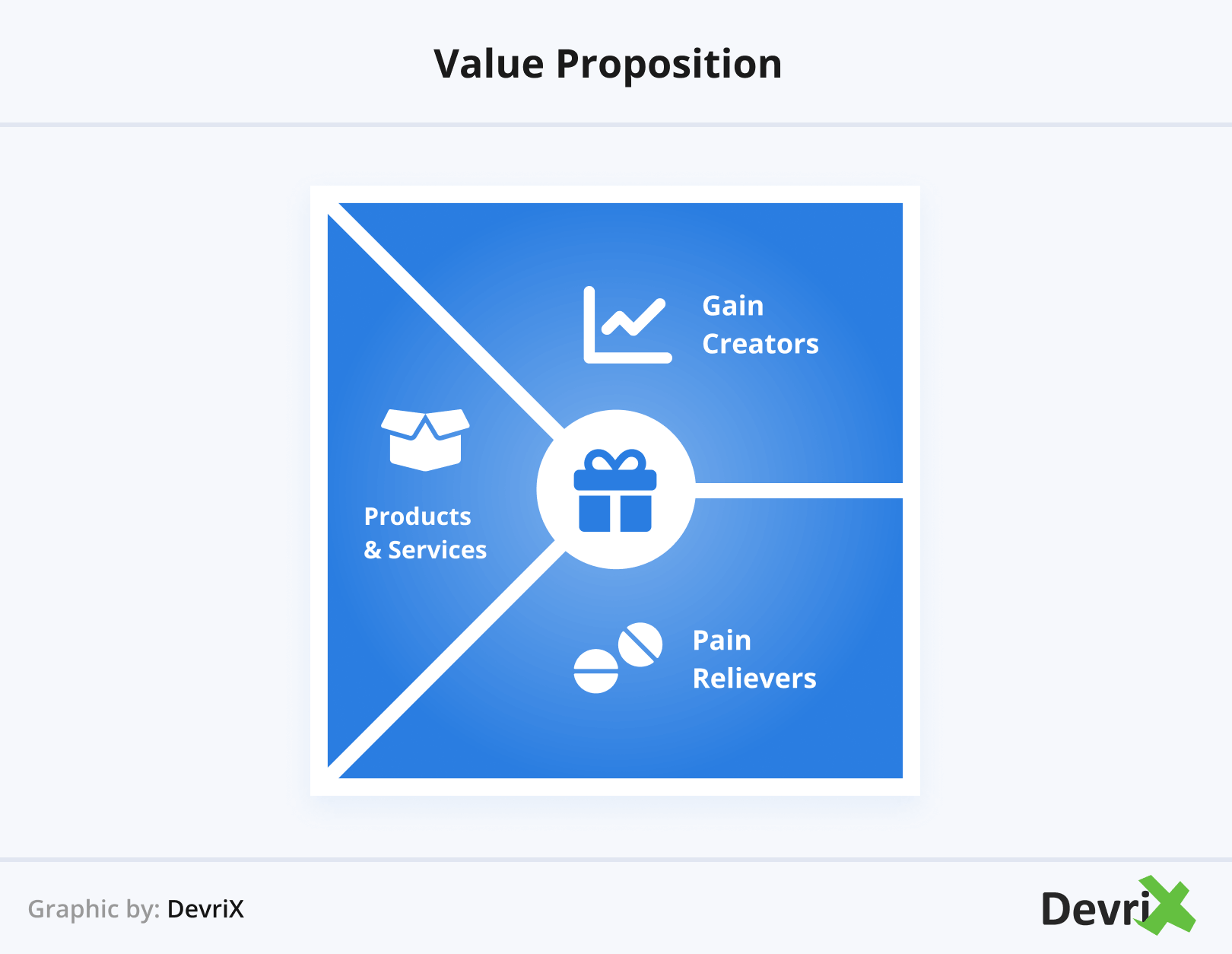
Once you are done with the client part, develop different value proposition canvases that match product and persona. This may take a while if you have a wide range of products, but it will enable you to streamline your product design, development, and marketing efforts, and improve sales.
The goal here is to understand how to meet and exceed the customer’s expectations. That’s also why each section of the product side of the canvas corresponds to one in the customer’s profile.
Analyzing the two parts of the framework side-by-side will not only help you identify silos and opportunities, but brainstorm ideas on how to implement them as well.
This way you can build a strong and compelling value proposition that the customer will find hard to resist.
Products and Services
In this section, you should add the products and services that you offer that can facilitate the customer’s jobs-to-do. If you have many products, focus only on those that best match the respective client. Also, if there are any specific features that make the product stand out, list them as well.
In the web development example, the products and services may be:
- Professional web development team.
- Custom WordPress development solutions.
- Creative and modern website design.
- Different plans for website maintenance.
- Business consulting and assistance.
Pain Relievers
Pain relievers showcase how you can resolve the customer’s issues, prevent negative outcomes, and improve their overall quality of life.
In the example, these can be:
- Flexible pricing based on the project and the client’s needs.
- Implementing a user-friendly CRM .
- Designing ad spaces and intrusive interstitials to meet Google’s user experience and quality regulations.
- Offering maintenance plans and lightning-fast customer service that can assist with urgent issues.
- Working with a creative team that is up-to-date with website design trends, and has a unique creative vision.
- A dedicated project management team that makes sure everything goes according to plan, and the final result meets the customer’s requirements.
Gain Creators
In order for the company’s value proposition to stand out and attract the customer’s attention, it should showcase the benefits that the company provides. These are the so-called gain creators.
For a web development company to seal the deal with the digital publisher client, these should include:
- A preliminary meeting where the company provides advice following the industry’s best practices and the latest digital publisher trends.
- A good history of working with similar clients and a portfolio of case studies and success stories.
- Testimonials from happy clients that the company helped out in tough situations.
- Extensive training and client onboarding that helps the customer learn how to operate and manage the website.
- SEO-oriented web development – building a responsive website theme with mobile-friendly layouts; focusing on user experience; optimizing for core web vitals; ad optimization; two-click penalty monitoring and management; etc.
- Providing a quick and efficient process and following a well-structured web development project management plan.
- Offering a wide range of supplementary services such as marketing, content marketing, SEO services, ad ops, etc.
- A variety of WordPress retainers plans which give the client access to the team’s services on a subscription basis.
Tips for Creating a Value Proposition Canvas
Here are some practical tips to leverage when filling your own value proposition canvas:
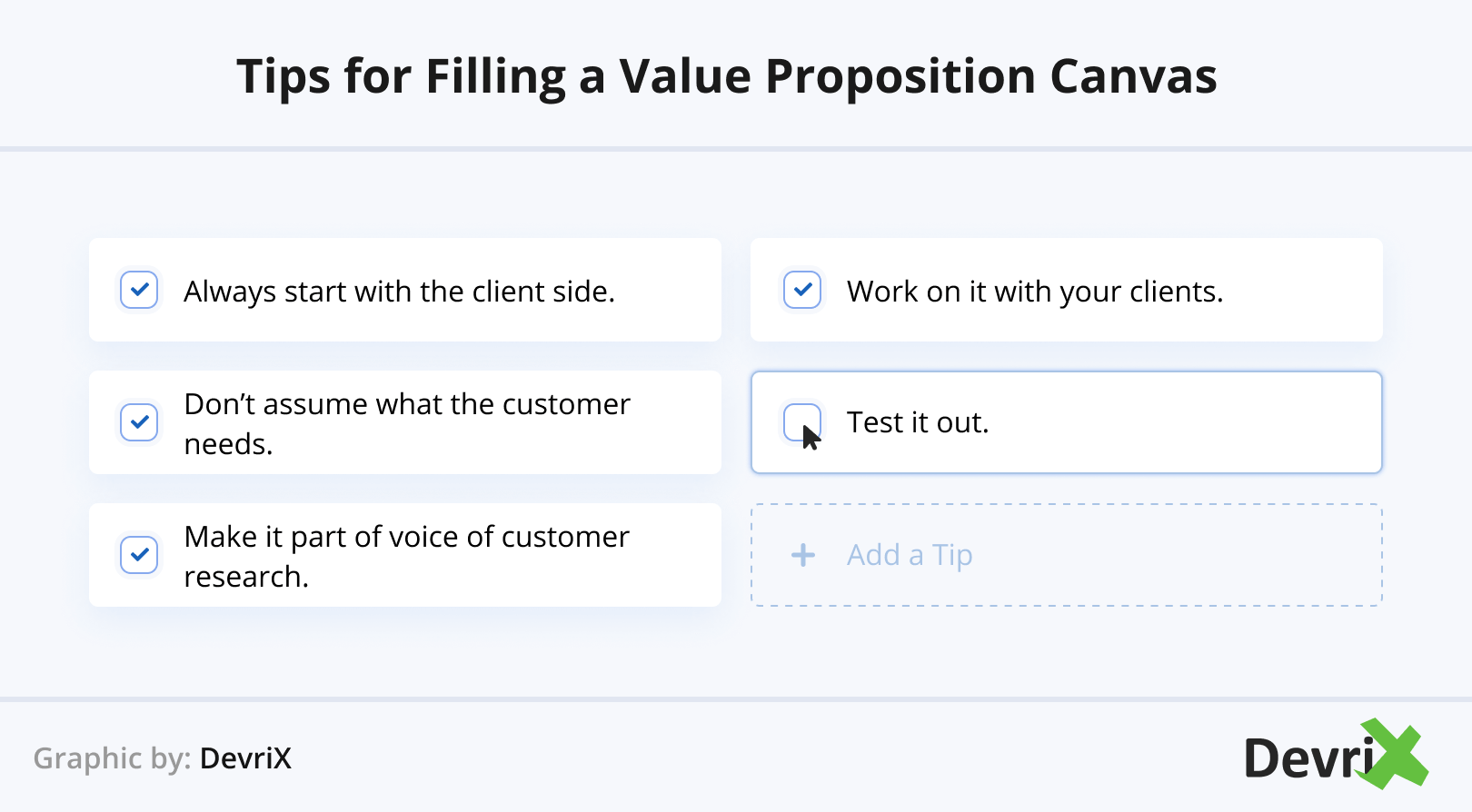
- Always start with the client side. You should always think of the customer first. This will reduce the risk of being biased and trying to match the client’s needs with the product, instead of the other way around.
- Work on it with your clients. Including real clients in the process and consulting with them will help you create the optimal product-market fit. They can show you what you are missing or misunderstanding, and provide valuable insights on selling points.
- Test it out. Once you’ve successfully created your value proposition, you should test it out to make sure you got it right. If it is not delivering the expected results, you should revise the two sides of the canvas to identify where the issues are coming from.
- Don’t assume what the customer needs. Basing the client’s profile on assumptions will result in a flawed canvas which doesn’t provide real business value. The goal of the framework is not to guess what the client’s jobs-to-do, pains, and gains are, but to motivate you to research and find them out.
- Make it part of voice of customer research. The best way to inform your value proposition canvas is to make it part of your voice of customer research. This way you will be able to build a hierarchy of the customer’s needs and focus on the most pressing and relevant ones.
Bottom Line
The value proposition canvas is a handy business tool that can be used both in the product development stage and in improving your business. It helps companies ask the right questions to better understand their clients and find the best product-market fit.
Using the information from the framework, companies can optimize their marketing message, personalize their targeting, and show their customers the true value of their products.
When making purchasing decisions, the client’s focus is on their own problems or issues, and so should be the company’s as well. They should meet the customer where they are and be clear about how they can help. And this is where the value proposition canvas comes in.
